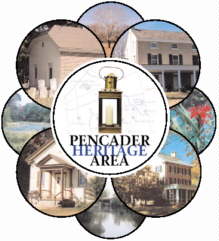 The original Welsh Tract Primitive Baptist Church was a log meeting house built in 1703 by a congregation that had been organized in Southern Wales, immigrated to Pennsylvania, and then, as a result of a disagreement over baptismal practices, split off from the main congregation and moved to Delaware. The present structure, with its distinctive half-hipped roof, was built in 1746. Drawings by architect Laussat Rogers, done in 1933, show the location of an earlier, bricked-in single front door, and also a rectangular bricked in patch on the west side where a window used to shed light on the pulpit. The pulpit has been moved to the southern end of the building, and the patch is often mistakenly described as the result of a cannonball passing through the church during a Revolutionary War skirmish that took place in the churchyard. Folklore also has a cannonball entering through a shutter on the east side and exiting through a window on the west side, with little damage to the building. The bricks are laid in Flemish Bond; the date stone over the door is sandstone.
The original Welsh Tract Primitive Baptist Church was a log meeting house built in 1703 by a congregation that had been organized in Southern Wales, immigrated to Pennsylvania, and then, as a result of a disagreement over baptismal practices, split off from the main congregation and moved to Delaware. The present structure, with its distinctive half-hipped roof, was built in 1746. Drawings by architect Laussat Rogers, done in 1933, show the location of an earlier, bricked-in single front door, and also a rectangular bricked in patch on the west side where a window used to shed light on the pulpit. The pulpit has been moved to the southern end of the building, and the patch is often mistakenly described as the result of a cannonball passing through the church during a Revolutionary War skirmish that took place in the churchyard. Folklore also has a cannonball entering through a shutter on the east side and exiting through a window on the west side, with little damage to the building. The bricks are laid in Flemish Bond; the date stone over the door is sandstone.
Old maps show a schoolhouse behind the church and six small houses across the street, one of which still remains. Two of the houses were taverns and the James family, who owned one of them, is said to have given Generals Washington, Greene and Lafayette shelter from a fierce thunderstorm that drove them off Iron Hill where they were spying on the British in the Chesapeake Bay.
The area surrounding the church was part of 30,000 acres deeded to three Welshmen: David Evans, William Davis, and William Willis. Known as the Welsh Tract, it included Iron Hill, and the Trustees of the Baptist Church purchased land that reached all the way to its northern slopes, now part of Interstate I-95. At one time Welsh Tract Road passed behind the church and continued up and over Iron Hill. Traces of the abandoned road, worn down by iron ore wagons, can still be seen to the southeast of the church.
The oldest tombstone in the walled cemetery is that of Rees Rhyddracks. It is inscribed in Welsh and dated 1707. Legend also
places unmarked graves of Revolutionary War soldiers somewhere in the peaceful churchyard. Research is continuing and hopefully,
someday, commemorative markers will tell the stories.
|
